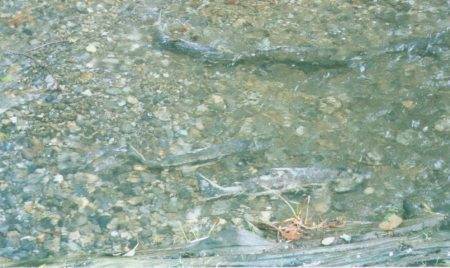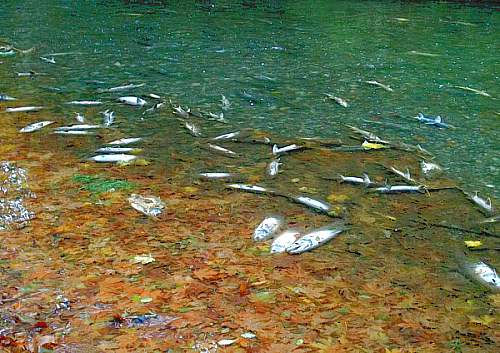 |
 |
| Home | Welcome | What's New | Site Map | Glossary | Weather Doctor Amazon Store | Book Store | Accolades | Email Us |
 | |||||||||||||||||||
Weather Almanac for November 2002WHEN SALMON CANNOT RUNThe dry weather over much of North America, particularly the mid-continent Prairie and Plains regions, has attracted much media attention as farmers watched drought decimate grain harvests, and foresters worried over raging wildfires and areas of extreme fire danger. (The 2002 season was the US's second greatest fire season of the past 50 years.) The lack of rain, however, has affected denizens of the great, wide Pacific Ocean at a critical stage of their lives. I speak of the Pacific Salmon species heading into coastal waterways to spawn.  After a very dry year on British Columbia's southern Vancouver Island in 2001, which necessitated extremely tough water restrictions through the summer and autumn months, early 2002 not only filled Victoria's Capital Region water reservoirs to capacity, they were overflowing at one point. Then in April, the rains slowed then stopped. By October, the region had experienced the driest April through October in 63 years: only 131.5 millimetres of rain at Victoria Airport, half the normal amount of 264 mm. To top it off, normally wet October — the usual start to the region's rainy season — dropped only 15 mm of the expected 75 mm of precipitation on the airport. Data collected at the region's Sooke reservoir indicated its driest October since 1895. Water storage levels at both the Sooke and the Goldstream reservoirs were down to 38 percent, prompting the Capital Region District Water Department to advise residents to use water wisely. While still a nuisance to human residents of the south island, the low water levels poised a hazard to the annual autumn salmon run. Chum salmon gathered in the Saanich Inlet, eager to enter Goldstream River at the Inlet's southern terminus. Reports from Fisheries officials indicated that in some areas of the Island, earlier spawners were backed up, three-deep in the deeper water. The bad news facing the salmon as the spawning season began was that many prime gravel nesting locations were high and dry due to low river levels. Stream surveys to determine the number of fish returning, a practice normally carried out by swimmers in wet suits, were cancelled on the Island's west coast because waters were not deep enough for swimming. According to Canadian Fisheries Department officials, the continuation of the dry weather could cause a very high pre-spawning mortality among the returning fish. The Goldstream River and Provincial Park
Goldstream Provincial Park contains the major spawning stream in the Victoria region, the Goldstream River. Chum, coho and chinook salmon all enter the river via the Saanich Inlet from the Pacific Ocean. Its proximity to the city makes it a well-visited park for tourists and residents alike. An estimated 100,000 people visit the park each year during the salmon run from late October through December to witness one of nature's spectacles. Goldstream Park is a naturalist's delight. Massive, 600-year-old western red cedar and Douglas fir rule a diverse forest containing western yew, red alder, big leaf maple, western hemlock and black cottonwood. On the drier ridges surrounding the lower park, flowering dogwood, lodgepole pine and arbutus grow. Wildlife in the park is abundant, numbering a myriad of shrubs, ferns, mosses, flowers, birds, insects and fish. Amongst the park's many trees and understory growth, a meandering river flows to the sea, reaching salt water at Finlayson Arm, the terminus of the Saanich Inlet, the lower Island's largest fjord. Cross the river at one point, and you can begin a hike to the top of one of the highest points in Greater Victoria: the 416-metre summit of Mt Finlayson. Take an alternate trail up Niagara Creek, a small tributary to the Goldstream River, and you will come to Vancouver Island's Niagara Falls, a thin, but tall waterfall, 47.5 metres high. (Ontario's mighty Niagara Falls are 56 and 54 metres high.)
The park's biggest draws, however, are the salmon and eagles. And the two are intimately related. Each year, chum, coho and chinook salmon return to their birthplace in the Goldstream River. Three to four years previous, they had left the river to enter the sea where they grew and matured. Now to fulfil the final chapter in their life story, they return to spawn and die in their ancestral spawning beds. Chum salmon spawn closest to the river mouth. Coho spawn further upstream, and the chinook furthest from the estuary.
By December, the Goldstream River and Estuary are filled with hundreds of tonnes of rotting salmon carcasses, an unpleasant aroma for human visitors, but heaven for the wily crows and ravens, several species of gull, and majestic bald eagles. Each winter, the estuary opens one of the Island's favourite winter dining spots for bald eagles who congregate in the surrounding forest to feast on the high-protein salmon carcasses. In the winter of 1990-1991, a quiet zone was created on the lower stretch of the Goldstream River, and visiting eagles increased from about a dozen to more than two hundred in the estuary's five-star eatery. The Goldstream River Spawn in 2002I took the opportunity this season to introduce Goldstream Provincial Park and the annual salmon run to two new residents of Greater Victoria. The first visit occurred in early November before the annual autumn rains finally began. That day, I was struck with the sluggishness and narrowness of the shallow river this year. As I walked along the river bank, I recalled a similar walk two years ago when heavy autumn rains saturated the surrounding soil had loosened the roots of one of the ancient red cedars and made the tree vulnerable to blow over by storm winds. Its giant trunk still lies where it fell, save for a section cut out to allow access to the main parking area. In that year, the pedestrian bridges over sections of the river were just barely above water level and Niagara Creek was a swift moving stream. This year, the creek bed is dry, save for a few puddles formed in recent rains, and the bridges well above the water surface. In many areas, the river's water is barely deep enough to cover the backs of the salmon, struggling to make their way upstream. Human intervention on the Goldstream River has attempted to help the salmon run this autumn. Water has been released from the Goldstream reservoir to assist this year's spawning population to fight their way upstream. Because of this release, hundreds of dorsal fins from the chum salmon are poking up through the shallow water. "If the water wasn't fed in from the reservoir, we would have been in huge, huge trouble...It's [the river level] still tremendously low," reported Darren Copley, naturalist for the Park's Freeman King Visitor Centre. Fisheries scientists watching the spawning run are quite concerned about the current low water levels. They are watching the chum spawning in intertidal areas normally shunned because eggs laid there have a lower survival rate. Many chinook are unable to get as far upriver as they normally would, thus causing cramped conditions for the spawners of all three species. Normally, there is space on the lower river for around 15,000 spawning salmon, but with the low water, it is estimated that there is only enough spawning grounds for 5,000.
Salmon Run, Goldstream River, November 2002Many prime gravel nesting locations are unreachable or bone dry because of the low water levels. This forces later-arriving fish to dig up, and thus destroy, earlier redds, salmon nests excavated in the stream-bed gravel, to spawn. During the week between my visits, the rains began on southern Vancouver Island, a hopeful sign for those fish still waiting in the ocean waters to make their spawning run. But much more rain must fall before the ground becomes saturated and thus allow later rains to run directly into the river and feeding streams. The rise in the lower Goldstream River is noticeable, however. The accompanying photograph shows a section of the river newly flooded. You can see the golden large leaves of the appropriately named big leaf maple in the water. These are leaves that fell onto the dry river bed before the recent rains. Now they lie submerged beneath many centimetres of water.  On the good-news side of the coin, the number of returning salmon is high. A recent survey of the Strait of Georgia found great numbers of salmon waiting for a change in weather to start their run. Surveyors have found more than 3.5 million chum salmon coming through the Strait of Georgia to spawn and "fairly good returns" for both coho and chinook stocks. We on the normally soggy Pacific Coast too pray this year for life-giving rains — to ensure the continuation of our legendary salmon. All photographs by Keith C. Heidorn, ©2002, All Rights Reserved. Map of Goldstream Provincial Park, courtesy BC ParksWritten by
|
|||||||||||||||||||
 |
To Purchase Notecard, |
Now Available! Order Today! | |
 |
 |
NEW! Now |
The BC Weather Book: |


